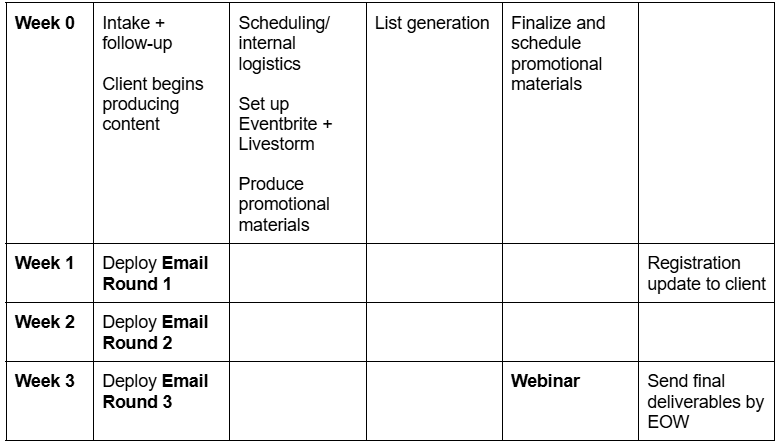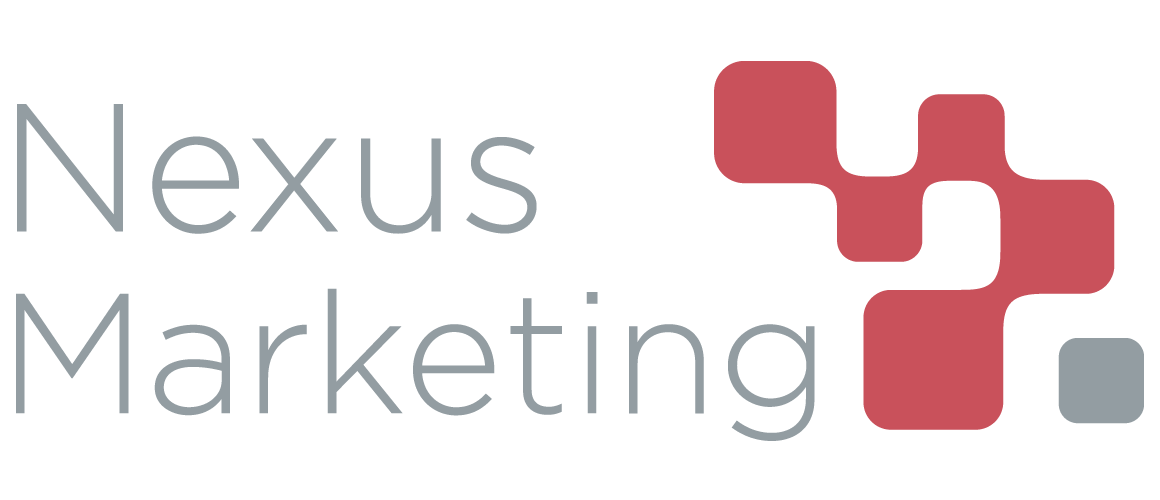What Can You Expect from the Nexus Webinar Process?
If you’ve just kicked off a new webinar program with Nexus, you may have a few questions.
This resource walks through what you can expect from the process, including who’s responsible for what, our recommendations for success, and an overview of a standard webinar timeline.
Webinar Kickoff
During your webinar kickoff meeting, we’ll align on key event details.
It’s helpful for you to consider these in advance so that the meeting can be as productive as possible. However, we’ll also provide recommendations and can chat through your options during the call if needed.
Here’s what we’ll aim to determine during your kickoff:
- Preferred date ranges for your event(s)
- Who will present your webinar content
- Your target audience for the event (job titles, organization categories, revenue ranges, etc.)
- Whether you’ll repurpose webinar content or develop a new presentation
- Topics you’d like to cover with your webinar program that will appeal to the target audience
During the call, we’ll provide available dates to choose from, initial audience segmentation recommendations, and topic suggestions (if needed).
What’s Needed From You Post-Kickoff
After the kickoff meeting, we’ll ask you to:
- Confirm the webinar date, time, title, and topic (if not finalized during the kickoff call)
- Share a bio and headshot of the webinar presenter
- Begin creating your webinar content (or repurposing existing content)
Using the event details, bio, and headshot, our team will have what we need to produce emails and promote the event. We’ll reach out closer to the event to ask for a copy of your presentation.
During the event, your team will need to:
- Join the virtual event 15-10 minutes early for a headcount and tour of the platform (if needed)
- Present the webinar content
- Engage the audience via chat (not necessary but recommended)
After the event, you’ll then:
- Receive your package of event deliverables:
- The webinar registrant and attendee list
- A recording of the event
- A chatlog from the event
- Begin using the email list to follow up with registrants and/or fold them into your normal outreach cadences
What We’ll Handle
After the kickoff call and once we’ve confirmed key details, we’ll then handle these steps:
- Scheduling your event
- Setting up the relevant event pages and integrations
- Laying out a promotional calendar
- Segmenting your audience based on your ICP input (if using our list)
- Developing promotional emails
- Scheduling and sending promotional emails
- Monitoring registration rates
- Making ad hoc adjustments and improvements to boost registration as needed
- Sending you one or more registration updates during the promotion period
During the event, our team will:
- Orient your team to the Livestorm event platform before the webinar begins
- Manage any backend issues that come up and offer technical support if needed
After the event, we’ll:
- Export the event recording and chatlog
- Send you a package of final deliverables, including registrant and attendee lists
Our Recommendations
As you begin thinking about the details of your upcoming webinar, we have a few suggestions that will help ensure it runs smoothly and generates the value you need:
- Have at least one other team member (aside from the presenter) on the call to monitor the chat and respond to questions. We’ve seen that webinars with active chats tend to generate more engagement and interest among attendees.
- Webinar topics should be tactical and compelling for mid-funnel audiences.
- For example, “Likes into sustainers: Crafting a 90-day social strategy for your nonprofit” vs. “The power of social media for nonprofits”
- If possible and depending on the date of your webinar, consider timely topics.
- For example, lean into year-end giving, affinity months, etc. and what they mean for your target audience.
- Webinar titles should be fewer than 75 characters and ideally acknowledge the target audience directly.
- For example, a webinar title could include “for nonprofits,” “for development teams,” “for CMOs,” etc.
The Webinar Timeline at a Glance
Here’s a general standard timeline for a Nexus webinar. Depending on the date of your webinar and other factors, your own timeline may vary, but we’ll fully align on what to expect prior to beginning work.

The entire webinar process generally takes 4 weeks, including preparation and promotions.
During Week 0, we’ll kick off your event by aligning on details and handling the prepwork. Starting now, we ask that you begin developing your webinar content.
Over the next three weeks, we’ll actively promote your webinar, monitor registrations, and keep you updated. We’ll plan to send promotional emails to your audience segment in three core blasts, but we may add additional email blasts as needed if we find that registration numbers are lagging. We’ll also notify you if we find that we need to adjust your event’s title to successfully convert more registrants.
Please don’t hesitate to contact your Nexus Marketing account team if you have any questions about the webinar process before or during your next project.
We look forward to making your next digital event your best yet!



